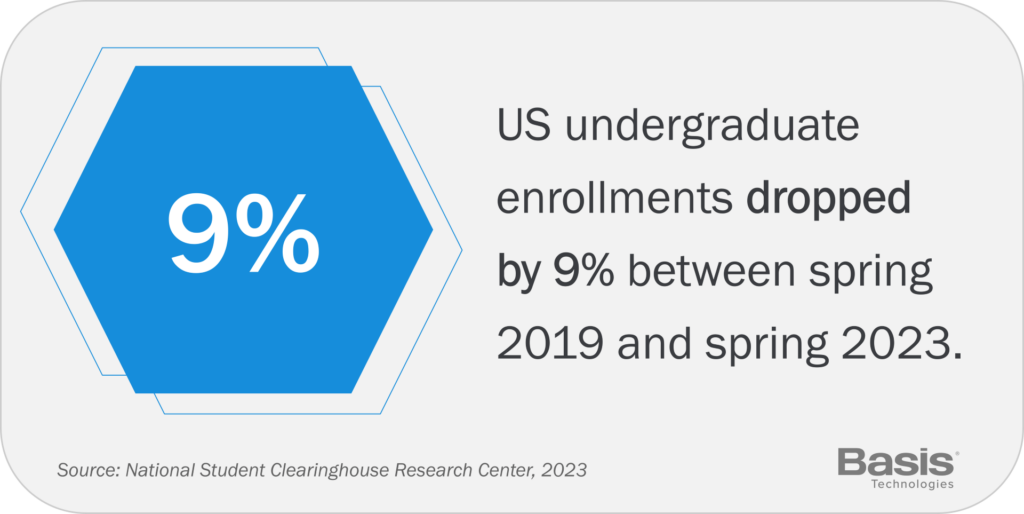
Like students cramming for a final exam, the pressure’s on for marketers at colleges and universities.
Undergraduate enrollment has declined since 2010, driven by increased skepticism about the value of a college degree and hesitance around acquiring student loan debt—even though college grads tend to earn more and experience lower rates of unemployment. The COVID-19 pandemic accelerated undergraduate enrollment declines, with rates dropping by a whopping 9% between spring 2019 and spring 2023. And though graduate enrollments saw a bump during the early days of the pandemic, those numbers also declined in 2023. Then there’s the looming college enrollment cliff, which promises a 15% decline in the number of college-aged students starting in 2025 due to lower birth rates during the Great Recession.

Add it all up, and it’s clear that 2024 will be a critical year for colleges and universities. The good news is this pressure has seriously upped the value of higher ed marketers. Smart leaders will be prioritizing and investing in their marketing teams, which gives marketers the opportunity to shine by taking creative approaches to big challenges.
Looking for some ideas to give your 2024 planning a competitive edge? Check out the following trends set to shape the year ahead:
Interest in online classes and flexible learning hasn’t slowed, and according to a survey of Chief Online Learning Officers at higher ed institutions, that demand for online courses will continue to grow in the years ahead. Students want online, virtual, and hybrid options, and savvy advertisers will prioritize showcasing these offerings as colleges and universities continue to invest in them. Providing digital experiences like virtual events and campus tours is a great way to show students that you know how to tailor engaging digital experiences.
Creating hyper-personalized ads for students will also be crucial for higher ed marketers in 2024. If a college or university can make prospective students feel like an ad is speaking specifically to them—and that the institution in question is a great fit—that can be an effective strategy for winning over individuals who may be on the fence. At the same time, this approach ensures that marketing budgets are spent as efficiently as possible.
Investing in research and having the ability to slice and dice data like enrollment numbers is key to supporting these efforts. Consumer personas in higher ed have shifted significantly in recent years, and the “traditional college student” persona has morphed into multiple target audiences. There are a lot more nontraditional students, such as part-time students or students enrolled in shorter-term non-degree programs. Marketers need partners who can pull research on consumer and market trends for them and then dig into their enrollment numbers to get specific about where it makes the most sense to invest.
In terms of executing on those hyper-personalized ads, programmatic advertising can provide targeting opportunities so that institutions can reach particularly niche audiences. For example, an omnichannel programmatic strategy allows teams to remarket individuals on higher funnel platforms—which are starting to remove some of their targeting capabilities and the data segments marketers can tap into with the onset of signal loss and third-party cookie deprecation—using insights gained from other channels. Leaning heavily into first-party or DMP data to really figure out what prospective students are looking at on your site and what their priorities are is another great way to maintain that hyper-personalization as we move away from third-party identifiers.
The growing use of artificial intelligence in marketing is a trend across all industries. For higher ed marketers, it’s important to start testing and learning with AI tools now so as to develop a comfort and ease with that skill set, which will put marketers in the best position to quickly jump on any new AI-based opportunities that may emerge in the next few years.
For target audiences, no matter the vertical, attention spans are a lot shorter than they used to be. However, this is especially true for the younger prospective students higher ed marketers are looking to target. Having access to AI-powered features like VR campus tours or chatbots that can answer people’s questions right away are very effective for keeping an audience engaged.
Also, some social platforms, like Meta and TikTok, offer integrations to create augmented reality components. Basically, marketers provide creative assets like images and headlines, and the platforms will try out different variations of those assets until it identifies what is going to perform the most successfully for individual consumers. It’s a great way to leverage AI for creative optimization.
Overall, the focus for savvy higher education marketers in 2024 will be on digital—not only marketing universities’ online and virtual opportunities, but also taking advantage of and getting comfortable with digital advertising tools that empower hyper-personalized advertising, such as programmatic and AI. Education marketers who lean into these digital opportunities are sure to pass with flying colors.
—
Hungry for more 2024 trends? Check out our 2024 Trends Report for everything digital marketers need to know for next year.